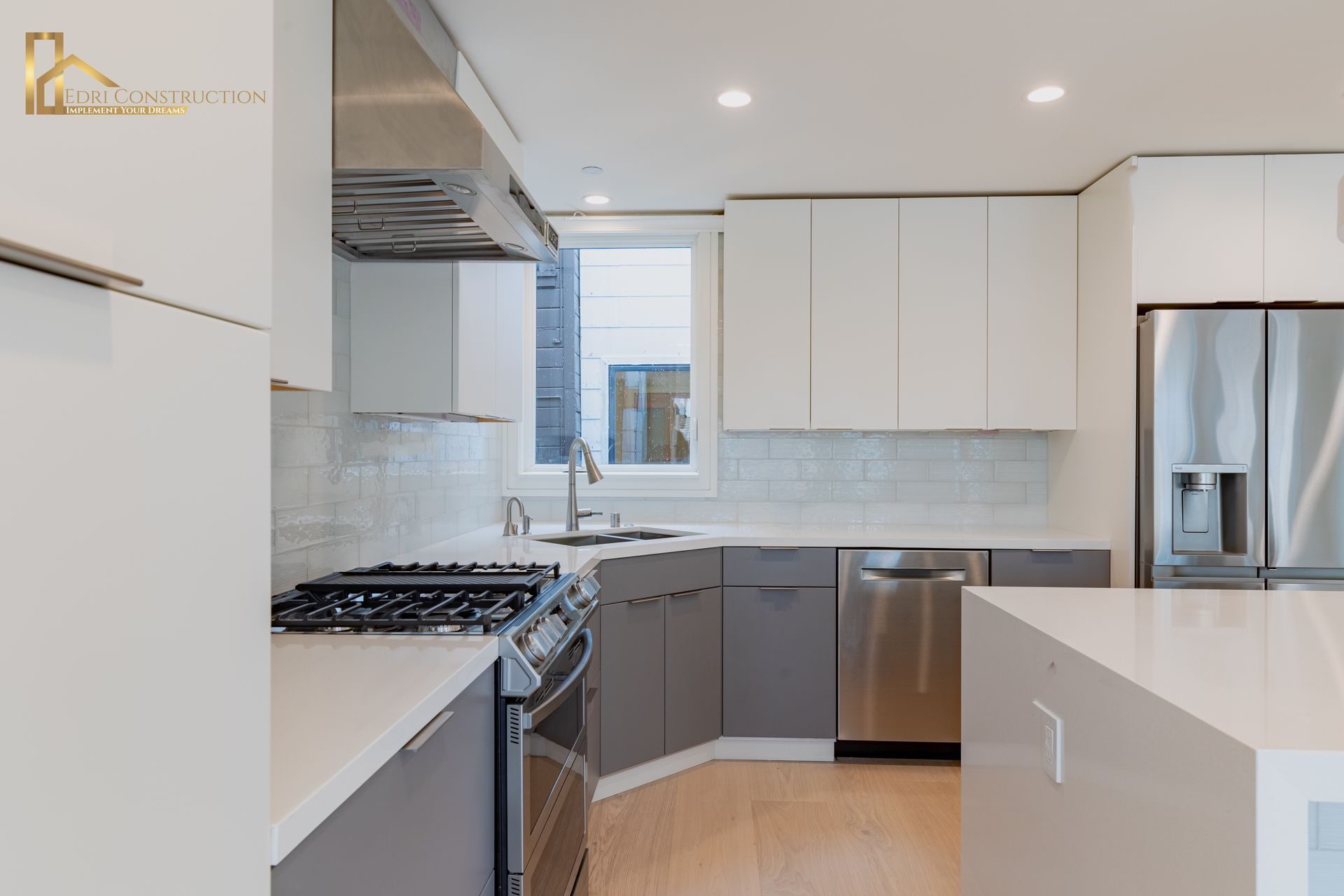What Are the Considerations for Sustainable Kitchen Remodeling Practices?

INTRODUCTION
Renovating your kitchen for a modern, functional space is a common desire among homeowners. Yet, in today's world, where environmental consciousness is increasingly important, the traditional approach to remodeling needs to evolve. Sustainable kitchen remodeling is not just about improving aesthetics and functionality; it's about making choices that benefit the planet too.
When embarking on a sustainable kitchen remodel, the first consideration is materials. Opting for eco-friendly materials such as bamboo, reclaimed wood, or recycled glass can significantly reduce your project's carbon footprint. These materials not only look great but also help conserve natural resources and reduce waste.
Another important aspect to consider is energy efficiency. Choosing energy-efficient appliances, such as dishwashers, refrigerators, and stoves, can lower your energy consumption and utility bills. Look for appliances with Energy Star certification, indicating they meet strict energy efficiency guidelines set by the Environmental Protection Agency.
In addition to energy-efficient appliances, installing LED lighting fixtures can further reduce energy usage in your kitchen. LED lights use significantly less energy than traditional incandescent bulbs and last much longer, reducing the need for frequent replacements.
Water conservation should also be a priority in sustainable kitchen remodeling. Installing low-flow faucets and water-efficient dishwashers can help minimize water waste. Additionally, incorporating a water filtration system can reduce the reliance on bottled water, cutting down on plastic waste.
Remodeling an Old Kitchen: The Foundation of Sustainability
Revamping an outdated kitchen presents a prime opportunity to embrace sustainable principles. Instead of immediately resorting to a total demolition, think about revitalizing what's already there and salvaging materials wherever feasible. Holding onto features like countertops, cabinets, and appliances isn't just about cutting down on waste; it's also about dialing back the environmental impact tied to producing fresh components.
Furthermore, bringing back to life vintage fixtures doesn't just add a touch of personality to your kitchen; it also champions the cause of conserving precious resources. When you embark on a kitchen remodeling project, consider the sustainability factor from the get-go. By opting for refurbishment over replacement, you're not only making a mindful choice for the environment but also potentially uncovering hidden treasures within your kitchen's existing framework.
So, before you go full steam ahead with a teardown, take a moment to explore the possibilities of breathing new life into what's already there. Who knows? You might just discover that the true beauty of sustainability lies in the art of renovation and preservation.
Sustainable Flooring Solutions: Eco-Friendly Foundations

Selecting the right flooring for your kitchen remodel is like laying the groundwork for a sustainable culinary sanctuary. The choices you make here are pivotal in ensuring your design aligns with eco-conscious principles. When it comes to flooring, think beyond just aesthetics and prioritize materials that are kind to the environment.
Embracing environmentally friendly options such as bamboo, cork, or reclaimed wood can set the tone for a greener kitchen floor. These materials boast renewable properties, meaning they can be harvested without depleting precious resources. What's more, they offer durability without sacrificing sustainability, making them a win-win choice for eco-conscious homeowners.
Bamboo, in particular, has gained popularity in recent years for its rapid growth cycle and resilience. It's a renewable resource that can be harvested sustainably, making it an excellent choice for eco-friendly flooring. Cork is another fantastic option known for its natural insulating properties and soft underfoot feel. Harvested from the bark of cork oak trees, it's a renewable material that can be harvested without harming the trees themselves.
Reclaimed wood adds a touch of history and character to your kitchen floor while also diverting materials from landfills. By repurposing wood from old buildings, barns, or warehouses, you're not only giving new life to discarded materials but also reducing the demand for virgin timber.
Crafting an Eco-Conscious Kitchen Remodeling Contract
Securing a sustainable kitchen remodeling contract is like laying down the green groundwork for your renovation journey. It's not just about revamping your space; it's about doing it in a way that's kind to the planet. When it comes to choosing contractors, opt for those who share your eco-conscious values and prioritize sustainable practices.
Working hand in hand with contractors who champion sustainability means you're already halfway to achieving your green goals. Look for professionals who specialize in energy-efficient appliances, non-toxic finishes, and eco-friendly construction materials. These contractors understand the importance of minimizing environmental impact and will work with you to ensure your project stays true to your values.
Incorporating clauses within your contract that specifically address waste reduction, recycling, and responsible disposal is crucial. By setting clear expectations from the outset, you're making it known that sustainability isn't just a preference—it's a non-negotiable priority. These clauses serve as a roadmap for both you and your contractors, guiding every step of the remodeling process with environmental integrity.
Throughout the project, communication is key. Keep the lines of communication open with your contractors, discussing any concerns or ideas related to sustainability as they arise. This collaborative approach ensures that everyone is on the same page and working towards a common goal of creating a kitchen that's both beautiful and environmentally friendly.
Cabinets: Reinventing Storage with Sustainability in Mind

When it comes to remodeling your kitchen cabinets, sustainability should be at the top of your list of priorities. Instead of simply searching for "kitchen cabinets remodeling near me," focus on finding eco-conscious options that align with your values. Opting for cabinets crafted from certified sustainable wood is a great starting point. Look for materials that have been responsibly sourced and certified by organizations like the Forest Stewardship Council (FSC). These cabinets not only help reduce deforestation but also ensure that you're making a positive impact on the environment.
Alternatively, consider eco-friendly alternatives such as bamboo or reclaimed lumber. Bamboo is a fast-growing, renewable resource that makes for durable and stylish cabinets. Reclaimed lumber, sourced from old buildings or structures, adds a touch of history and character to your kitchen while reducing the demand for virgin timber.
In addition to choosing sustainable materials, think about innovative storage solutions that maximize efficiency and minimize waste. Pull-out shelves, adjustable racks, and modular organizers are just a few examples of how you can optimize your cabinet space. These features not only make it easier to organize your kitchen but also help reduce clutter and waste.
Embracing DIY Kitchen Remodeling Ideas: Empowering Sustainability
Delving into DIY kitchen remodeling isn't just about sprucing up your space; it's a chance to embrace sustainability in every hammer swing and paint stroke. With a bit of creativity and elbow grease, homeowners can embark on projects that not only breathe new life into their kitchens but also minimize waste and promote eco-friendly practices.
One of the most exciting aspects of DIY remodeling is the opportunity to upcycle old furniture and repurpose salvaged materials. Instead of tossing out that worn-out dresser or unused cabinet, consider giving it a second chance at life as a kitchen island or storage unit. Not only does this approach breathe new life into old pieces, but it also reduces the demand for new materials and minimizes landfill waste.
Additionally, DIY enthusiasts can explore tutorials and guides that promote eco-friendly practices throughout the remodeling process. From refurbishing cabinets to crafting homemade countertops, there's a wealth of resources available for those looking to minimize their environmental footprint. By opting for materials like reclaimed wood or recycled glass, homeowners can create stunning, one-of-a-kind features that add character to their kitchens while supporting sustainability.
Energy-efficient lighting fixtures are another area where DIYers can make a significant impact. By installing LED bulbs or solar-powered lights, homeowners can reduce energy consumption and lower their utility bills. Plus, with the wide range of DIY tutorials available online, it's easier than ever to tackle electrical projects safely and efficiently.
Partnering with Kitchen and Bath Remodeling Companies Committed to Sustainability

Start by researching companies that prioritize environmental stewardship in their work. Look for firms that actively incorporate eco-friendly practices into their design and construction processes. This might include sourcing sustainable materials, minimizing waste, and reducing energy consumption during the build.
One way to identify environmentally conscious remodeling companies is to seek out certifications such as LEED (Leadership in Energy and Environmental Design) accreditation. This designation indicates that a firm has met stringent sustainability standards set by the U.S. Green Building Council. By partnering with LEED-certified companies, you can have confidence that your renovation project will be conducted with a strong commitment to environmental responsibility.
Collaborating with conscientious professionals not only ensures a sustainable outcome but also provides peace of mind throughout the remodeling process. These experts have the knowledge and expertise to navigate the complexities of sustainable design and construction, guiding you through each step with care and consideration.
During the planning phase, discuss your sustainability goals and priorities with your chosen remodeling company. Together, you can explore innovative solutions and eco-friendly materials that align with your vision for a green renovation. Whether it's selecting energy-efficient appliances, installing water-saving fixtures, or incorporating recycled materials into the design, your remodeling team can help bring your sustainable aspirations to life.
Remodeling Apartment Kitchens: Sustainable Solutions for Urban Living
First and foremost, focus on maximizing space efficiency. Opt for multifunctional appliances and compact storage solutions that make the most of every square inch. Think fold-down tables, pull-out pantry shelves, and cleverly designed cabinets that maximize storage without crowding the space. By optimizing your layout, you can create a kitchen that feels larger and more functional while minimizing waste.
When selecting appliances, prioritize energy efficiency. Look for models that carry the ENERGY STAR label, indicating they meet strict energy efficiency guidelines set by the Environmental Protection Agency. These appliances are designed to minimize resource consumption without sacrificing performance, helping you save money on utilities while reducing your environmental impact.
In addition to choosing energy-efficient appliances, consider advocating for eco-conscious upgrades within your building or community. This could include lobbying for composting programs, advocating for energy-efficient lighting retrofits, or encouraging the installation of water-saving fixtures. By fostering a culture of sustainability within your urban dwelling, you can inspire positive change on a larger scale and make a meaningful impact on your community's environmental footprint.
Engage with your building management or homeowners' association to discuss potential sustainability initiatives and explore ways to implement them collaboratively. Whether it's organizing a community garden, hosting educational workshops on sustainable living, or coordinating group purchases of eco-friendly products, there are countless ways to promote sustainability within your building or neighborhood.
Luxury Kitchen Remodeling: Elevating Elegance with Environmental Responsibility

Luxury kitchen remodeling presents a golden opportunity to merge lavishness with environmental consciousness. It's about creating a space where elegance meets eco-responsibility, and every choice reflects a commitment to sustainability.Start by selecting high-end materials that prioritize the planet. Consider options like recycled glass countertops, which not only exude luxury but also minimize environmental impact by repurposing materials that might otherwise end up in landfills.
Incorporating smart home technology into your luxury kitchen can further enhance its environmental credentials. From automated lighting and thermostat controls to energy-monitoring systems, these innovations allow you to optimize energy usage and enhance convenience while minimizing environmental impact.
For a truly luxurious touch, consider integrating elements of biophilic design into your kitchen space. Biophilic design seeks to connect occupants with nature, and what better place to do so than in the heart of your home? Think living walls adorned with lush greenery, indoor gardens filled with herbs and plants, or even strategically placed windows to maximize natural light and views of the outdoors. Not only do these elements add a touch of tranquility and beauty to your kitchen, but they also help improve indoor air quality and promote a sense of well-being.
With thoughtful planning and discerning choices, luxury kitchens can epitomize both sophistication and sustainability. By selecting high-end materials, incorporating energy-efficient appliances and smart home technology, and embracing biophilic design principles, you can create a culinary oasis that not only dazzles the senses but also nurtures the planet for generations to come.
Illuminating Sustainability: Remodeling Kitchen Lighting with Efficiency in Mind
When it comes to remodeling kitchen lighting, it's not just about brightening your space—it's about illuminating sustainability. By embracing energy-efficient practices and innovative designs, you can light up your kitchen while dimming its environmental footprint.
Incorporating natural light into your kitchen design is another key strategy for promoting sustainability. By strategically placing windows, skylights, or solar tubes, you can maximize the amount of natural light that enters your kitchen, reducing the need for artificial lighting during daylight hours. Not only does natural light brighten your space and create a more inviting atmosphere, but it also helps to lower energy costs and minimize your environmental impact.
To further optimize energy usage, consider implementing dimmer switches and motion sensors in your lighting design. Dimmer switches allow you to adjust the brightness of your lights based on your needs and preferences, reducing energy consumption and extending the lifespan of your bulbs. Motion sensors automatically turn lights on and off based on occupancy and activity levels, ensuring that energy is only used when needed.
By prioritizing efficiency and innovation in your kitchen lighting design, you can brighten your space while minimizing its environmental impact. Whether it's choosing energy-efficient LED fixtures, maximizing natural light, or implementing smart lighting controls, every decision you make contributes to a more sustainable kitchen. So, as you embark on your remodeling journey, remember to shed light on sustainability and illuminate your kitchen in more ways than one.
Transforming Spaces: Small Kitchen Remodeling Ideas Before and After

When it comes to small kitchen remodeling, thinking big about sustainability is the key to unlocking transformative potential. By embracing minimalist design principles, you can maximize space efficiency while minimizing material consumption, turning your compact kitchen into a sustainable haven of efficiency and style.
Start by adopting a minimalist approach to design, focusing on simplicity and functionality. Choose clean lines, neutral colors, and streamlined fixtures to create a sense of openness and tranquility in your small space. By reducing clutter and unnecessary adornments, you can make the most of every square inch while also minimizing your environmental footprint.
When selecting appliances for your small kitchen, prioritize compact models that offer functionality without overwhelming your space. Look for energy-efficient options that are appropriately sized for your needs, helping to conserve resources and lower energy consumption. By opting for smaller appliances, you can also free up valuable counter and storage space, further enhancing the efficiency of your kitchen layout.
Utilizing vertical storage solutions is another effective way to maximize space efficiency in a small kitchen. Consider installing open shelving or hanging racks to make use of vertical wall space for storing pots, pans, and utensils. Not only does this free up valuable cabinet space, but it also adds visual interest to your kitchen while keeping essential items within easy reach.
Exploring creative layouts and multifunctional furniture can also help maximize versatility in your compact culinary space. Consider incorporating a kitchen island with built-in storage or a fold-down dining table that can double as a prep area. By thinking outside the box and maximizing every inch of space, you can create a small kitchen that meets your needs without compromising on style or sustainability.
Conclusion
Sustainable kitchen remodeling practices offer a blueprint for creating functional, stylish, and environmentally responsible culinary spaces. From refurbishing old kitchens to embracing DIY endeavors, every decision holds the potential to minimize waste and maximize sustainability. By prioritizing eco-friendly materials, energy-efficient appliances, and responsible construction practices, homeowners can remodel their kitchens with confidence, knowing that they are contributing to a greener future. Whether you're embarking on a modest renovation or a luxurious overhaul, sustainability can be the guiding principle that transforms your kitchen into a beacon of environmental stewardship and modern elegance.
Frequently Asked Questions (FAQ) - Sustainable
Kitchen Remodeling
What is sustainable kitchen remodeling?
Sustainable kitchen remodeling involves renovating your kitchen with a focus on minimizing environmental impact and maximizing resource efficiency. This includes using eco-friendly materials, energy-efficient appliances, and responsible construction practices to create a more sustainable living space.
Why is sustainable kitchen remodeling important?
Sustainable kitchen remodeling is important for several reasons. It helps reduce carbon footprint, conserves natural resources, minimizes waste generation, and promotes healthier indoor air quality. Additionally, it aligns with modern principles of environmental stewardship and contributes to a greener future.
What are some eco-friendly materials for kitchen remodeling?
Eco-friendly materials for kitchen remodeling include bamboo, cork, reclaimed wood, recycled glass, and certified sustainable wood. These materials are renewable, recyclable, or salvaged from existing sources, making them environmentally responsible choices for your kitchen renovation.
How can I make my kitchen remodeling project more sustainable?
You can make your kitchen remodeling project more sustainable by incorporating energy-efficient appliances, installing eco-friendly fixtures, maximizing natural light, using low-VOC paints and finishes, and recycling or repurposing materials whenever possible. Working with contractors and designers who prioritize sustainability is also key.
Are there any incentives for sustainable kitchen remodeling?
Depending on your location, there may be incentives or rebates available for sustainable kitchen remodeling. These incentives could include tax credits, grants, or financing programs aimed at promoting energy efficiency and environmental conservation. Check with local government agencies or utilities to explore available incentives in your area.
How does sustainable kitchen remodeling contribute to energy efficiency?
Sustainable kitchen remodeling contributes to energy efficiency by incorporating energy-efficient appliances, LED lighting, and smart home technology. These features help reduce energy consumption, lower utility bills, and minimize greenhouse gas emissions associated with traditional kitchen operations.
Can I remodel my kitchen sustainably on a budget?
Yes, you can remodel your kitchen sustainably on a budget by prioritizing cost-effective eco-friendly materials, focusing on energy-efficient upgrades that offer long-term savings, and considering DIY options for certain aspects of the renovation. Planning and research are key to achieving a sustainable remodel within your budget constraints.
How can I find contractors who specialize in sustainable kitchen remodeling?
You can find contractors who specialize in sustainable kitchen remodeling by conducting online research, asking for referrals from friends or family members, or consulting with local green building organizations. Look for contractors with experience in eco-friendly construction practices and a commitment to environmental stewardship.
What are some green certifications to look for in kitchen remodeling products?
Some green certifications to look for in kitchen remodeling products include Energy Star certification for appliances, Forest Stewardship Council (FSC) certification for wood products, GreenGuard certification for low-emission materials, and WaterSense certification for water-efficient fixtures. These certifications indicate that products meet certain environmental and performance standards.
How can I maintain sustainability in my kitchen after remodeling?
To maintain sustainability in your kitchen after remodeling, practice energy and water conservation, minimize waste generation through recycling and composting, choose eco-friendly cleaning products, and support local farmers and producers by purchasing organic and sustainably sourced ingredients. Regular maintenance of appliances and fixtures also helps prolong their lifespan and reduce environmental impact over time.










